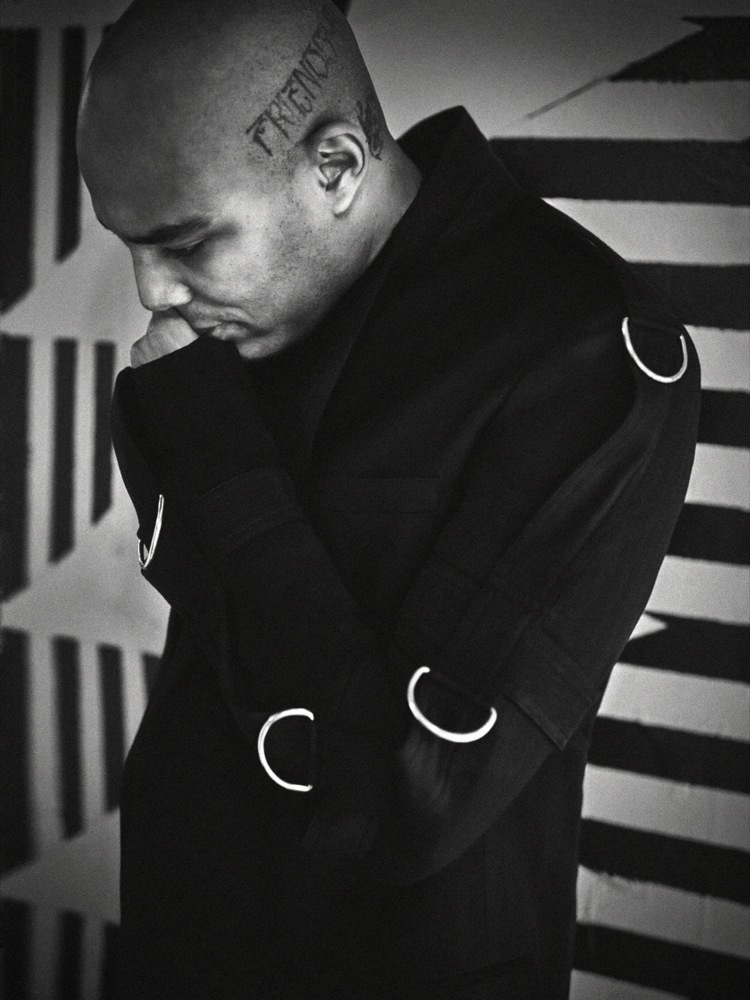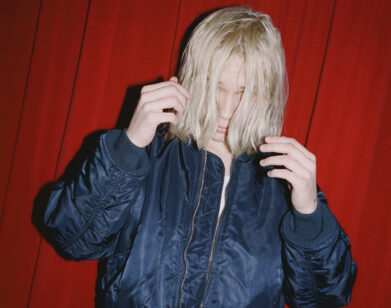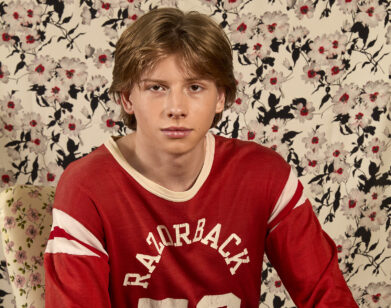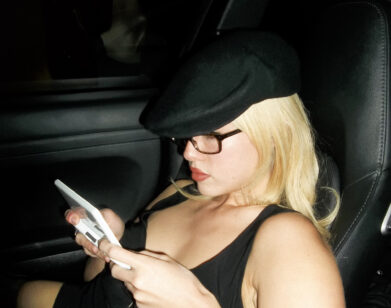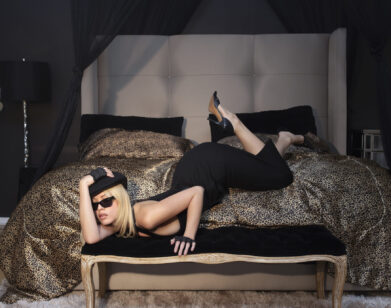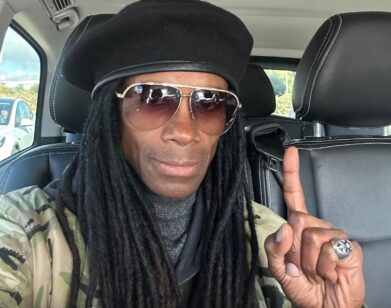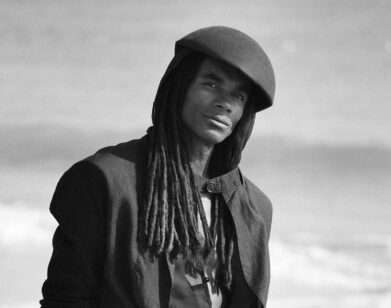Holt without Hollywood
NIGEL HOLT (HXLT) IN BROOKLYN, NEW YORK, FEBRUARY 2016. PHOTOS: JAMES RYANG. STYLING: MAC HUELSTER. GROOMING: REN NOBUKO. SPECIAL THANKS: LOOKING GLASS.
Chicago-born, raised, and based artist Nigel Holt released an eponymous debut album under his surname, stylized HXLT, last week—his first since growing beyond his previous moniker Hollywood Holt. “Even with the name change, people call me a rapper, and I’m not,” he confidently says. As Hollywood Holt, the artist became an established name within the Chicago rap scene, amongst childhood friends like Chance the Rapper, Vic Mensa, Virgil Abloh, and his cousin Mano, who, for a while, was Kanye West‘s DJ. Now, however, HXLT returns via West’s label G.O.O.D Music with a cleaner sound, embellished with the live instrumentation of rock and catchiness of pop.
Much like how Holt controls every aspect of his visuals (album art, video direction, et al.), HXLT was produced and written entirely by the artist—save for two songs. One track features production by Mano (“he’s my cousin, my best friend, he knows the direction I want to go in, so I let him have a song”), and on another, the listener hears music and vocals from punk legend Kathleen Hanna. Holt’s swift change in direction might seem abrupt, but he’s a man of many talents, exemplified through his past work as a professional break-dancer and achievements like producing Beyoncé and Andre 3000’s cover of Amy Winehouse’s “Back to Black” for The Great Gatsby soundtrack. It was this cover, not his rapping, that caught West’s attention in 2013, eventually leading to HXLT signing with G.O.O.D. Music.
Just after the release of HXLT, we spoke with Holt over the phone about changing names, religion, and wanting to fly.
EMILY MCDERMOTT: Can you tell me what led to the transition from Hollywood Holt to HXLT, and from rap to a more kind of pop-rock?
HOLT: I really love rapping, but it’s not my greatest skill set, in my opinion. I always felt I could do much more, but I made a couple of rap songs and they happened to blow up, so I got all of this great stuff by being a rapper and performing. As an artist, I felt like I was cheapening myself. I never had that feeling of, “Wow, I’m doing something great.” When I finally decided, “I’m going to make whatever I feel like,” I got that feeling. If I had come out as Hollywood Holt making rock music, they would have called me a rock rapper and that’s the worst thing you can be called. [laughs] I didn’t want to be in any kind of vein as Fred Durst—no offense to Fred Durst. I just didn’t want people to misconstrue what I was doing as some rap-rock hybrid because I hate that style of art.
MCDERMOTT: I know you do your own stunts in videos and all of the creative direction comes solely from you. What was the shoot like for the album’s cover art?
HOLT: When you’re coming up as an artist, you really learn to get your confidence correct. When I was [younger], I thought because I didn’t physically hold the camera that I had to give all the credit to other people. With this project, I know I do everything. People will tell you that you need help, that you need things you don’t need. I tried a couple of times, like, “Hey what are you thinking for this video?” and they told me a stupid idea. I have a creative vision, so I have a small team that helps me facilitate, but I shoot and direct and concept everything.
[For the album], I wanted my imagery to be provoking. I’m a very hyperactive person and I’ve always wanted to break through a window and fly out. I grew up watching action movies where they break through the window; I grew up wanting to do that. When I was young, I saw this Rage Against the Machine album cover where they have the Buddhist monk who set himself on fire. You stare at that image for hours. You’re seeing something so intense that happened so quickly, and you’re able to analyze it and take it in. I wanted to do that for my album cover as well, and it wouldn’t have been right unless I jumped out the window. It needed to be me.
MCDERMOTT: So you actually broke the window?
HOLT: That’s the other thing—I went on YouTube and figured out how to make sugar glass. I was going to buy it, but it was so expensive, and you only get a couple of sheets, you have to ship it, and it’s not guaranteed that it won’t break on the way. So I looked it up how to make it. I got the ingredients and went to my apartment and cooked sugar glass. We made four sheets and makeshift frames, some wood and aluminum foil, and cooled them in the snow. The next day we transported them very slowly to the place, my friends held the glass near the open window, and I ran and jumped through it, eight times.
MCDERMOTT: And one song features Kathleen Hanna. Can you tell me how she became involved?
HOLT: Quickly, I want to set the record straight: I don’t think I’m a punk artist or a punk rocker, I don’t think I play punk music, but as a person, I am punk. I enjoy listening to punk music; I enjoy performing and going to shows. It just so happens that my live shows are very punk, but my actual music—I don’t think it’s punk. It just has derivatives of punk. People keep saying [it’s punk music], but I have never said that about my music. But, I am a punk rock person, that’s my sub-culture; I go to punk shows, I listen to punk music, I make punk jackets, and Kathleen Hanna is like the High Priestess of the punk world. She surpasses what’s popular and what’s cool. For me, having Kathleen Hanna on my record is the biggest solidification of my authenticity because she understood my music. I didn’t think she would be down, but when we reached out to her, she responded herself, said she loved it, and said yes. She sent me back the music parts in two days and didn’t ask for a single dollar. She just really believed in the music. I split the [proceeds of the] album with her out of respect because there’s only a certain amount of real tastemakers and creators who make an entire subgenre, and she’s one of those people. She has influenced an entire generation.
MCDERMOTT: Do you remember the first time that you encountered her music, or her writing?
HOLT: Yes, I was at a house party in California. I started listening to punk when I was 14 but I would hide it because every time I tried to play it, somebody would look at me like I was funny and wanted to fight. But one time it actually worked…I was in Los Angeles, for a breakdance battle, I used to be a break-dancer, and was crashing at my buddy’s house. I played a CD with break-beats and it had a Clash song on it. I was like, “Oh shit, I forgot the Clash song was on there,” and he was like “Yo, you like The Clash?” He ended up liking punk rock and put me on to a bunch [including Bikini Kill].
MCDERMOTT: I know you grew up in and around the same circle as Kanye West, but your cover of “Back to Black” is how you really became part of G.O.O.D. Music. What does that song mean to you?
HOLT: No one has ever asked me that and it means a ton to me. The first time I heard Amy Winehouse, I felt instantly connected to her. I felt like I knew her, and felt like if we knew each other we’d be good friends. You heard her music and instantly knew that was her. It was genuine and real. You could not mistake her music for anybody else’s. So I was a fan for a really long time and “Back to Black” really spoke to me at that time. Then, I played Lollapalooza the same year she did and I ended up meeting her backstage. She was kind of already in the downs; she was really skinny and around that one guy, but she was still really cool, funny, and super down to Earth. When I was talking to her, it was like I knew it, like “Man, she’s going to die soon.” It made me so sad because she was going to be an iconic artist for life; she was James Dean level, forever. When I met her, I saw it in her eyes. From being around people that died from drugs, I know that look, and she very much had it.
So I always wanted to cover “Back to Black,” and when I first started my project with [producer] Le Fonz, I started with that song. I played the guitar parts, made the bass-line, and made the beat. It came out so naturally. I really put my emotion into that production, which I think is what grabbed Kanye’s attention.
MCDERMOTT: I can’t even imagine having met her. Did you watch Amy?
HOLT: Yeah, it killed me. How people forced her to perform like that killed me—like, this girl needs help and y’all are so scared about getting your money! Every time she had a glimmer of hope, you guys messed it up because you wanted to be famous. What she needed was some good gangsters that were going to hold it down, who would have said, “Yo, sit your ass down, you ain’t going nowhere.”
MCDERMOTT: On another note, in one of our photos it looks like you have a large cross tattoo on the back of your head, so I want to ask what role religion plays in your life, if any?
HOLT: I feel like there are some people who, if they didn’t have religion, would go crazy and do ridiculous things. Then there are people who, because of religion, do those crazy things. There are people who kill in the name of God, but also people who say, “If the Lord wasn’t in my heart, I would shoot you in your head.” I personally believe in God, that he exists, that he created us, and so forth, but I don’t believe in organized religion. I think organized religions are all saying the same thing in different ways. To me, it’s like, be a good person, treat people the way you want to be treated. God, to me, has put into our soul what to do and what not to do. When you harm an animal, you will feel bad. If you break someone’s heart, you feel bad. Those things are put into you; it’s not something you are taught. Something tells you not to kill. Something tells you not to eat your own shit. So I don’t think I need religion, but I know what I believe. The thing on the back of my head is not actually a cross, though. It’s a diagonal “H” and a redesign of the Orthodox cross, just because I think some of the most beautiful designs are religious.
MCDERMOTT: So I read in an interview that you’re most relaxed when you’re crowd surfing or doing a backflip, which seems counter-intuitive. How does that make you feel relaxed?
HOLT: The day I was born I was crazy hyper. I’ve never not been hyper, never not jumped off of the top of the bunk bed—always a ball of energy. I never liked anything that took it away, and that’s why I never got into drugs. I would see people smoke weed and be chillin and calm; I liked being sharp and quick. I started to do gymnastics. They would have springboards and I would run and do really big backflips. I was used to doing backflips on the ground [with breakdancing] and I would have to get over really quick, so when I did the springboard, I started slowing down. The first time I did it, I got really high and felt like I was floating in mid-air. I was suspended and felt this freedom and calm. I felt like a bird. Even when I ran and jumped through the window, I felt that hard hit, but after that it was just freedom, just flying through the air. I guess I just want to be able to fly.
HXLT IS OUT NOW VIA G.O.O.D. MUSIC. FOR MORE ON THE ARITST, VISIT HIS WEBSITE.

